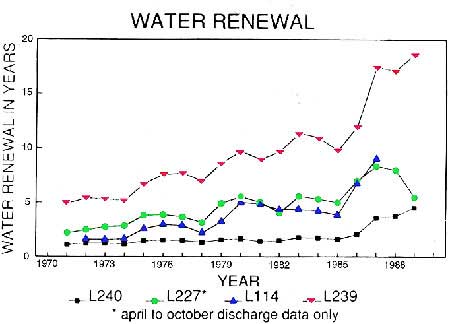 Alberta's WaterIntroductionPublications Climate Change Industrial Impacts Agricultural Impacts Urban Impacts Biodiversity Loss Definitions Links Site Map |
 |

A Few Impacts of Climate Change
|
 |

|
| Water renewal times in the experimental lakes area of Ontario. As water is replaced less often, ions such as sodium and chloride become more concentrated. | Stumpy Lake, Alberta, shows the effects of reduced water levels and longer water renewal times. Salts have precipitated onto once-submerged wood. |
The picture above, right, shows Stumpy Lake, near Kinsella, Alberta. Drying can greatly change the chemical composition of a lake, and some salts can reach maximum solubility. Typical calcium bicarbonate waters can become dominated by sodium sulfate or other salts, depending on local geology. Sodium chloride, which is more soluble than many other salts, becomes dominant during drying, and very few organisms are able to tolerate the high levels of salinity. This picture shows carbonate salts that precipitated onto once-submerged wood in Stumpy Lake as the water level declined in the '80s-'90s. Photo: Dr. Jeff Curtis


